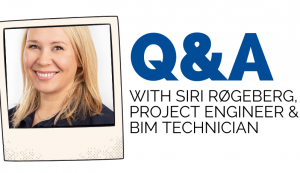This Woman’s Work: Q&A with Siri Røgeberg

Women constitute only a small fraction of the engineering workforce, which is why it is essential to listen to their voices when considering how the construction industry might tackle its gender imbalance. In this interview Siri Røgeberg, Project Engineer/BIM Technician at HAKI shares an insight into her role as a female engineer, focusing particularly on why it’s important to provide more opportunities for women interested in joining the sector.
Q: What is it like to be a female engineer?
A: Well, I love to be an engineer and a woman, also! Although I never thought I’d be an engineer as a child, I feel that now it is the perfect career choice for me.
Q: What made you decide to become an engineer?
A: I wanted to be an architect actually, yet I felt as if it was too artistic for me. I loved Math too, so I chose to be a constructional engineer! I have a degree in engineering from OsloMet University and have worked at HAKI for just over a year.
There are two reasons why I love to be an engineer. I meet interesting people all of the time, where I get to talk to them and offer help. No project is the same, so our clients and my colleagues have lots of great conversations. I cherish the collaborative element of engineering!
Q: Why did you decide to pursue a career in BIM?
A: I think the short answer is that I could create 3D models all day!
I also have a BIM qualification which puts me in a good place within HAKI. Around three years ago I decided to enrol on a part time BIM course, as I realised that the construction industry was heading in that direction.
The opportunity for a BIM specialist and an engineer arose at HAKI, and I was very lucky to have the correct skillset to perform both of these duties within one job. It has been great to see BIM become an important service offering to HAKI’s clients, and I feel proud to be part of this new age.
Q: What is your daily routine at work?
A: Each day is very different and dependent on which stage a project is at. If it is within the early stages then I would do sketches. But with BIM, we are able to offer our clients impressive 3D models and videos so they can present a sophisticated scaffold design to their customers. This visibility puts the client at a strong advantage to secure the new work.
Q: In your opinion, where is BIM heading?
A: Customers are recognising that they have to give something more to their clients and themselves. In the one year I have been at HAKI, I have seen a huge change in the way our customers value BIM. BIM is still in its infancy in the scaffold sector and it is so exciting to see how far it will go.
Q: How does HAKI inspire you?
A: I think HAKI is a unique company within the scaffold industry which has a healthy work culture. This environment is instrumental in ensuring both the staff and clients are happy.
I also want to add that the HAKI team listens to what I have to say. It is one of the most important ways to feel respected and valued at work.
As a woman in a male-dominated sector you do have to work harder to get the respect, to some degree. This isn’t the case at HAKI however, as the company definitely creates a safe space for me as an engineer. We have a lot of women in technical positions – I couldn’t say the same for other companies! HAKI really invests and believes in the people that work here.
Q: What advice would you give to an aspiring engineer?
A: I would encourage them to take the leap of faith like I did! If the industry as a collective can look past appearances, it will be able to realise that we are all the same!
Q: What’s next for you?
A: HAKI is really invested in developing the capabilities of its people. My role will definitely change as BIM technology evolves, and I am thrilled to be working for a company which enables me to drive the adoption of new technologies, for the benefit for ourselves and the clients.
 Haki has now acquired vertemax – Discover the
Haki has now acquired vertemax – Discover the 